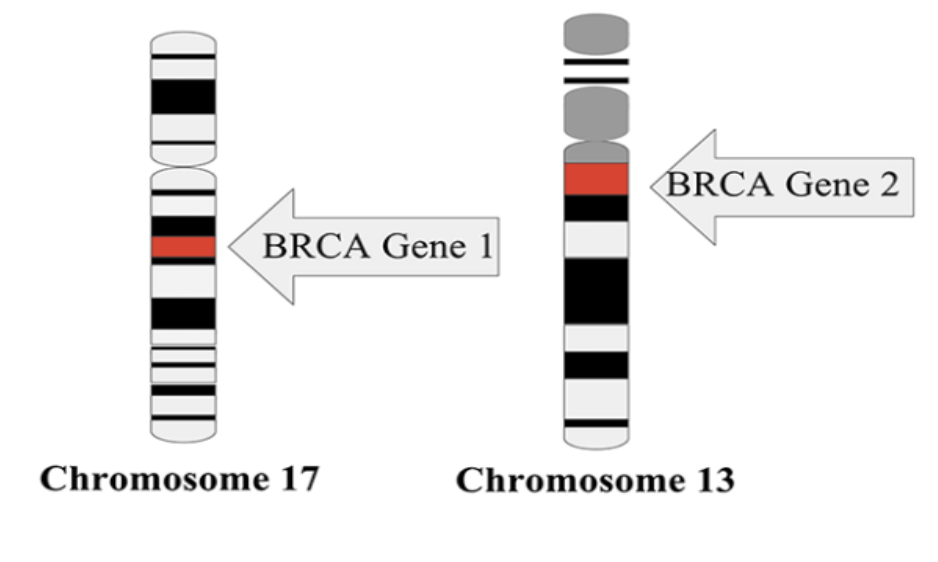A Review of Chromosome Structure and Function
With the time spent learning about breast cancer in Dr. Pollock’s lab, I have become more interested in learning if X-linked genes are associated with breast cancer. Before we get into the details, let’s take a top-level look at human genetics. There are two sex chromosomes in humans: X chromosomes and Y chromosomes. Females typically have two X chromosomes, while males have one X and one Y chromosome (National Library of Medicine, 2024). Humans usually have 46 chromosomes or 23 pairs of chromosomes. Chromosomes are thread-like structures made up of protein and DNA that are passed from parents to offspring. Chromosomes keep DNA tightly wrapped around histones and ensure DNA is accurately copied and distributed in cell division (National Human Genome Research Institute, 2020). When there is a change in the number or structure of chromosomes in new cells, it can lead to problems such as being more susceptible to cancers like leukemia or breast cancer.
The BRCA Genes
The BRCA1 and BRCA2 genes may sound familiar from Angelina Jolie undergoing a double mastectomy so that she wouldn’t get breast cancer. Angelina Jolie underwent a procedure called a prophylactic double mastectomy where she had both of her breasts removed even though she hadn’t been diagnosed with breast cancer (Watson, 2013). Angelina Jolie came to this decision after discovering she carried the BRCA1 gene which significantly increases the odds of developing breast cancer or ovarian cancer.
The BRCA1 and BRCA2 genes are the two most common genes in autosomal dominant forms of breast cancer; that means that the mutated genes can be passed from parent to child. The BRCA1 and BRCA2 genes produce tumor suppressor gene proteins, so when any mutations change the gene, it can lead to an increased risk of developing breast cancer (Mehrgou & Akouchekian, 2016). Of the 43 chromosomes found in the human body, the BRCA1 gene is located on chromosome 17q and the BRCA2 gene is located on chromosome 13q or near the end of the chromosome in men. The BRCA1 and BRCA2 genes have anti-oncogenes or tumor suppressor genes that help repair damaged DNA in cells, so if either gene is damaged, then there will not be any DNA repair and can eventually lead to mutations that lead to cancer (Mehrgou & Akouchekian, 2016).

So, why should we care about the BRCA1 and BRCA2 genes? Well, 55-72% of women who inherit a harmful BRCA1 variant and 45-69% of women who inherit a harmful BRCA2 variant will develop breast cancer by the age of 70 (National Cancer Institute, 2020). To put this into perspective, let’s say a male (XY) and female (XX) want to have offspring, if the male carries an autosomal dominant allele which is an altered BRCA1 gene passed to them by their mom, then the chance of their daughter carrying the autosomal dominant allele is 50%, but if both parents carry the dominant allele, then the daughter is at much higher risk of developing breast cancer or becoming a carrier even after one of their X chromosomes are inactivated. Breast cancer is not as common in men because they only have one X chromosome. Even if their mother was a carrier of the autosomal dominant allele, their chances of having breast cancer are far less likely than if it was a daughter that has two X chromosomes.
What about other diseases?
To add on, women are also more susceptible to autoimmune diseases which is when the body’s immune system mistakenly attacks healthy tissue, organs, and cells. Examples of autoimmune diseases are lupus, rheumatoid arthritis, and inflammatory bowel disease. Why is this true? Researchers have found that a coating (a mix of RNA and proteins) is central to a developmental process called X-chromosome activation rather than flawed gene regulation inducing susceptibility to autoimmune diseases (Dolgin, 2024). A specific gene called XIST (long non-coding RNA) which is normally expressed only in XX cells has been linked to being relevant in human autoimmune conditions in women. There is hope that studying this gene can eventually help with disease management by targeting autoantibodies (Dolgin, 2024).
What can we do?
Overall, it is fascinating to think about how genes and chromosomes play very important roles in our lives, especially in women. We don’t have any control over what genes have been passed down from our parents or will be passed down to our offspring but our genetics affect our lives drastically. After learning more about this, I am far more interested in getting a genetic test and looking for genetic changes or mutations in my DNA. Staying informed of any potential genetic conditions including whether or not cancer runs in my family would be very advantageous.
Genetic tests are a type of test that are used to identify changes in genes, chromosomes, or proteins which can help rule out a suspected genetic condition or help determine an individual’s chances of passing down or developing a genetic disorder (MedlinePlus, 2021). To be more specific, gene testing studies DNA sequences to identify mutations in genes that can cause or increase the risk of a genetic disorder. If you wanted to test for the BRCA1 or BRCA2, then the BRCA gene test would be the best test to take because it looks for DNA changes that increase the risk for breast cancer or ovarian cancer. Genetic tests are often covered by insurance companies and are as simple as getting your blood drawn or a sample of your saliva. What about you? Do you want to be informed?
Briseily Cejudo
Biology Major
Class of 2025
Resources
National Library of Medicine. (2024). X chromosome: MedlinePlus Genetics. Medlineplus.gov. https://medlineplus.gov/genetics/chromosome/x/#:~:text=The%20X%20chromosome%20is%20one
National Human Genome Research Institute. (2020, August 15). Chromosomes Fact Sheet | NHGRI. Genome.gov. https://www.genome.gov/about-genomics/fact-sheets/Chromosomes-Fact-Sheet
Mehrgou, A., & Akouchekian, M. (2016). The Importance of BRCA1 and BRCA2 Genes Mutations in Breast Cancer Development. Medical Journal of the Islamic Republic of Iran, 30(1), 369. https://www.ncbi.nlm.nih.gov/pmc/articles/PMC4972064/
National Cancer Institute. (2020, November 25). BRCA gene mutations: Cancer risk and genetic testing fact sheet – National Cancer Institute. Www.cancer.gov. https://www.cancer.gov/about-cancer/causes-prevention/genetics/brca-fact-sheet#:~:text=Breast%20cancer%3A%20About%2013%25%20of
Dolgin, E. (2024). Why autoimmune disease is more common in women: X chromosome holds clues. Nature. https://doi.org/10.1038/d41586-024-00267-6
National Cancer Institute. (2017). Study Affirms Cancer Risk for Women with BRCA Mutations. National Cancer Institute; Cancer.gov. https://www.cancer.gov/news-events/cancer-currents-blog/2017/brca-mutation-cancer-risk
Watson, S. (2013, May 15). Angelina Jolie’s prophylactic mastectomy a difficult decision. Harvard Health Blog. https://www.health.harvard.edu/blog/angelina-jolies-prophylactic-mastectomy-a-difficult-decision-201305156255
MedlinePlus. (2021, July 28). What is genetic testing? Medlineplus.gov. https://medlineplus.gov/genetics/understanding/testing/genetictesting/

Recent Comments